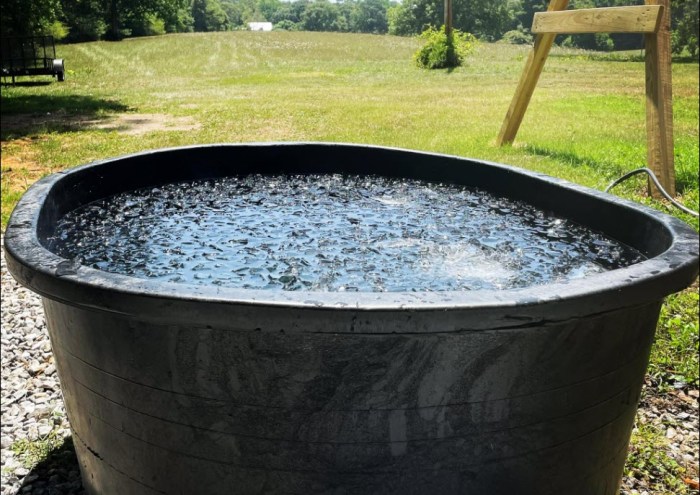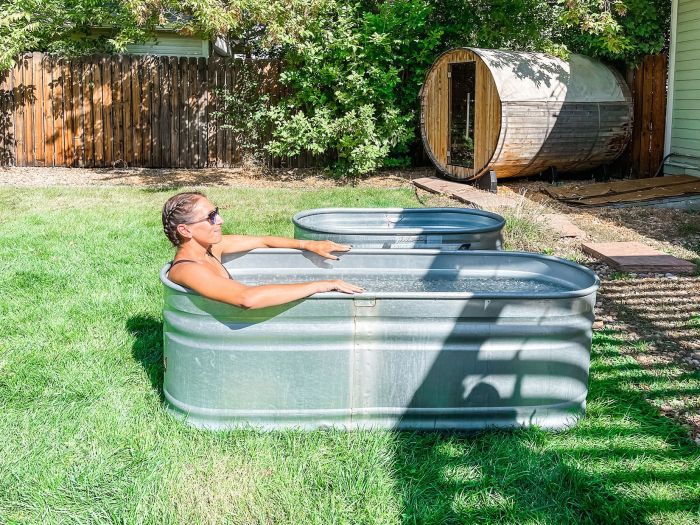DIY Ice Bath Tub: Want to experience the benefits of ice bath therapy without breaking the bank? Building your own ice bath tub is easier than you think, and can be a great way to enhance your recovery and performance. From using a large cooler to modifying an existing bathtub, there are several DIY methods to choose from, each with its own advantages and considerations.
This guide will walk you through the process, covering everything from choosing the right materials to ensuring safety and proper maintenance. We’ll explore different construction methods, provide tips for creating the perfect ice bath experience, and even discuss cost-effectiveness and sustainability. So, grab your tools and let’s dive into the world of DIY ice bath tubs!
Alternative DIY Ice Bath Options

If you don’t have a dedicated ice bath tub, there are other DIY options you can explore. These options offer different levels of convenience and cost, so it’s essential to weigh the pros and cons of each before making a decision.
Portable Ice Bath Tubs, Diy ice bath tub
Portable ice bath tubs are a convenient and affordable option for those who don’t have the space or budget for a permanent installation. These tubs are typically made of durable plastic or rubber and come in various sizes.
Advantages of Portable Ice Bath Tubs
- Portability: These tubs can be easily moved and stored, making them ideal for those who live in smaller spaces or want to take their ice bath on the go.
- Affordability: Portable ice bath tubs are generally less expensive than custom-built tubs.
- Ease of Setup: Setting up a portable ice bath tub is relatively simple, requiring only filling it with water and ice.
Disadvantages of Portable Ice Bath Tubs
- Limited Capacity: Portable tubs typically have a smaller capacity than permanent installations, which may not be suitable for taller individuals.
- Durability: Portable tubs may not be as durable as permanent installations, especially if they are frequently moved or exposed to harsh conditions.
- Aesthetics: Portable tubs may not be as aesthetically pleasing as custom-built tubs, especially if they are not made of high-quality materials.
Creating an Ice Bath in a Swimming Pool
If you have access to a swimming pool, you can create an ice bath by adding a significant amount of ice to a designated area. This method is a good option for those who already have a pool and want to experience the benefits of an ice bath without investing in a separate tub.
Advantages of Using a Swimming Pool
- Space: This method takes advantage of existing space, eliminating the need for additional equipment.
- Flexibility: You can adjust the size of the ice bath area based on your needs and the pool’s size.
- Multi-purpose: You can use the pool for other activities, such as swimming or relaxation, when not using it for an ice bath.
Disadvantages of Using a Swimming Pool
- Large Amount of Ice: You will need a significant amount of ice to create a proper ice bath in a pool, which can be expensive and time-consuming.
- Temperature Control: It can be difficult to maintain a consistent temperature in a pool ice bath, as the water will warm up quickly.
- Safety: Ensure the pool is properly secured to prevent accidents, especially if children are present.
Adapting a Regular Bathtub for Ice Baths
You can adapt a regular bathtub for ice baths by adding a layer of insulation to prevent heat loss and using a large amount of ice. This method is a good option for those who want to use their existing bathtub for ice baths without investing in a separate tub.
Advantages of Adapting a Bathtub
- Cost-Effective: This method is cost-effective as it utilizes existing equipment.
- Accessibility: Most homes have a bathtub, making this method easily accessible.
- Comfort: A regular bathtub provides more comfort than a portable tub.
Disadvantages of Adapting a Bathtub
- Temperature Control: It can be challenging to maintain a consistent temperature in a bathtub ice bath, as the water will warm up quickly.
- Insulation: Proper insulation is crucial to prevent heat loss, which can be time-consuming and require additional materials.
- Cleaning: Cleaning a bathtub after an ice bath can be more challenging than cleaning a dedicated ice bath tub.
Cost-Effectiveness and Sustainability: Diy Ice Bath Tub

Building a DIY ice bath tub can be a cost-effective and sustainable alternative to purchasing a commercial one. However, it is crucial to consider the materials and construction methods to ensure both financial savings and environmental responsibility.
Cost-Effectiveness
- Materials: The cost of materials for a DIY ice bath tub can vary depending on the size, design, and materials used. Generally, DIY options can be significantly cheaper than commercially available tubs. For example, using a readily available plastic storage bin as the base can be much more affordable than purchasing a dedicated ice bath tub.
- Labor: The labor cost for building a DIY ice bath tub is also minimal compared to purchasing a pre-built one. With basic DIY skills and readily available materials, individuals can construct an ice bath tub within a few hours, eliminating the need for professional installation.
Sustainable Materials and Practices
- Recycled Materials: Utilizing recycled materials, such as repurposed plastic storage bins, old bathtubs, or even wooden barrels, can reduce the environmental impact of building an ice bath tub.
- Natural Insulation: Employing natural insulation materials, like cork or recycled denim, can help retain the cold temperature of the ice bath while reducing reliance on synthetic materials.
- Water Conservation: Implementing water conservation practices, such as using a smaller tub or filling it only partially, can minimize water usage and reduce the overall environmental impact.
Environmental Impact
- Energy Consumption: Ice bath tubs require energy for cooling the water, which can contribute to greenhouse gas emissions. However, using renewable energy sources, such as solar power, for cooling can significantly reduce the carbon footprint.
- Water Usage: Ice bath tubs require a significant amount of water, which can be a concern in areas with water scarcity. Using water-saving measures, such as collecting rainwater or using a smaller tub, can help mitigate this impact.
- Waste Management: Ice bath tubs can generate waste from the ice and water used. Implementing responsible waste management practices, such as composting the ice and using reusable water containers, can minimize the environmental impact.
Building your own DIY ice bath tub can be a rewarding project that allows you to reap the benefits of ice bath therapy without spending a fortune. By following the guidelines Artikeld in this guide, you can create a safe and effective recovery station in your own home. Remember to prioritize safety, use high-quality materials, and maintain your ice bath tub regularly to ensure its longevity. Embrace the challenge, enjoy the process, and experience the refreshing benefits of your very own DIY ice bath tub!
Creating a DIY ice bath tub can be a refreshing and invigorating experience, especially after a tough workout. However, if you’re prone to anxiety, consider taking an antihistamine like atarax before immersing yourself in the cold water. This can help to minimize any potential discomfort or anxiety associated with the temperature change, allowing you to fully enjoy the benefits of your DIY ice bath tub.
